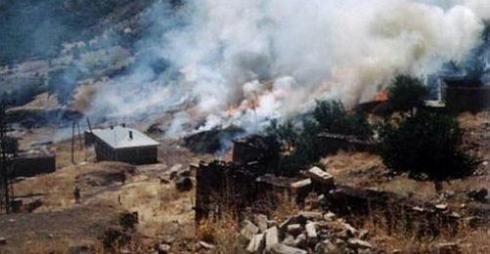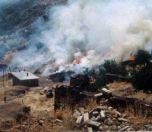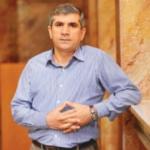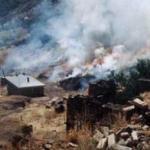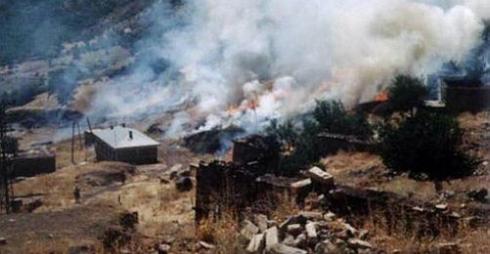
The European Court of Human Rights found Turkey guilty of “bombarding villages” regarding the Kuşkonar Massacre in 1994. The incident had been narrated in detail in “Weapons Transfers and Violations of the Law of War in Turkey”, a Human Rights Watch Project report book by James Ron.
At the time, the report was translated into Turkish by Ertuğrul Kürkçü who had been later on tried and convicted. bianet is releasing the full case published by Human Rights Watch.
CASE 3 Summary:
On March 26, 1994, according to five witnesses interviewed by Human Rights Watch, two Turkish fighter-bombers dropped four large bombs on the village of Ku§konar (traditional name: Gever) in §irnak province. The bombs were dropped after a helicopter overflight and after the fighter-bombers made an initial dry run over the village. There is little question, therefore, that the bombing was deliberate.
Two of the bombs landed directly in the middle of the village, then inhabited by about 150 civilians. Twenty-four villagers were killed, including twelve children aged fifteen and under. Seven of the bodies were so badly mangled they were unrecognizable except for the remaining shreds of clothing. The reasons for the bombing remain unclear. According to witnesses, there were no PKK fighters in the village at the time of the bombing, but for several days prior to the attack villagers had been under intense pressure from the government to join the village guard system, and there is also some indication that the villagers were planning to boycott the local elections, scheduled for the following week. According to the U.S. State Department, the Turkish authorities denied responsibility for the raid when asked; the U.S. government said in its June 1995 report to Congress, however, that its personnel "have determined that raids did take place and that some civilians were killed."
According to Turkish human rights groups, at least four additional air raids took place in the same area during March 24-26, 1994, killing an additional eighteen persons. All the names of the dead are available.
Description:
M.B., aged forty-five, told Human Rights Watch that his village had been under intense pressure from the authorities since the autumn of 1993 to join the village guards. "We didn't want to become guards," he said, "but we didn't have much choice." In the autumn of 1993, soldiers who were engaged in counterinsurgency operations in the surrounding mountains bivouacked in the village for a week, using it as their operational base. In December 1993, some of the villagers, including M.B., were told to report to the local Jandarma headquarters. "They asked us if we would leave the village when ordered," M.B. said, "and we said we would." No direct order to leave came, however, but gradually, most of the villagers drifted away. About 150 people were still living in the village when the Turkish Air Force struck.
M.B. said he was in his home on the morning of March 26, 1994, when a helicopter overflew the village. "It circled around for a while and then left," he recalled. Some time after the helicopter's overflight, two jets inspected the village at close range, flying no more than 100 meters off the ground. "They flew so low I could see their pilots," M.B. recalled. The jets climbed back up into the air, circling around to prepare for a second run over the village. "I realized that something was about to happen," M.B. said, "so I gathered my family and we ran toward a nearby cave." When M.B. reached the cave, situated one hundred meters away, the two Turkish jets began their first bombing run over Kuşkonar.
The jets flew in single file. The first plane dropped a bomb, began to climb back into the sky, and was then followed by the second jet, which did the same. M.B. saw two bombs drop from the aircraft. The bombs exploded on impact, sending up clouds of smoke and dust. "It was like an apocalypse," he recalled. Pieces of rock, gravel and rubble from the houses flew into the air, scattering hundreds of meters from the epicenter. The first two explosives hit directly in the center of the village, where tens of houses were packed in densely together, some no more than a meter apart.
The jets climbed back up over the hills and then made a second bombing run. They again dropped one bomb each, but these hit on the edge of the village. One bomb dropped one hundred meters away from the village center in a ravine near the main road leading to Kumçatı (traditional name: Dergiil), while the second dropped fifty meters away on a mountainside.
For some time, M.B. said, the cloud of smoke and dust was so thick that the "day had turned to night." When the cloud settled, M.B. and others walked to the village center and began to pull the bodies from the rubble. "It was almost impossible to tell who was who," he said. "The bodies were all in pieces, scattered around. Eight of them were so badly burned and destroyed that we could not recognize them. Later, we figured out who they were by their clothes and by who was missing," he said. From memory, M.B. listed the names of the casualties he recalled, which matched the names published by the Human Rights Association of Diyarbakır shortly after the air raid.
M.B. said the village was filled with bomb fragments, which he described as being as large as "two hands put together," with razor-sharp edges. The outside of the fragments were painted black, and the insides were painted yellow. He said the bombs had created four huge craters, "taller than a man" and three by two meters wide.
A.B., a forty-year-old municipal employee in the nearby town of Cizre, told Human Rights Watch he came to Ku§konar, his home village, a day after the bombing. "First we collected the pieces of the bodies," he recalled, "then we placed the pieces in sheets." A.B., working with fifteen other men, dug a two-meter wide trench in which they placed twenty-four bodies, seven of which he said were unrecognizable.
S.B., aged thirty-five, came to Ku§konar from Adana, where he was working, two days after the raid. He told Human Rights Watch in a separate interview that he recalled seeing "thirty or forty houses destroyed" when he arrived. "Most of the bodies had been buried by the time I came," he said. He spoke with surviving members of his family, who told him the bomb struck in the morning while they were eating. His sister, brother-in-law and their three children were all killed. He drew a map of the village and pointed out the position of the bomb craters; his drawing matched the descriptions supplied to Human Rights Watch by M.B. and A.B.
T.F., a fifty-year-old resident of Mersin, told Human Rights Watch he encountered three wounded women from the village of Kuşkonar at the end of March 1994. One of the wounded was aged seventy, the second was aged thirty- eight, while the third was twenty-six years old. "They were badly burned," he recalled, "and were hurt so much they couldn't speak." T.F. took the wounded women to a private hospital, since they were afraid to go to Mersin State Hospital. "They thought they would be arrested by the authorities," he explained.
The U.S. State Department's June 1995 report to Congress on human rights in Turkey said that press reports listed four villages bombed by aircraft and some twenty civilians killed. According to the State Department, "The GOT [Government of Turkey] denies this raid took place but USG [U.S. Government] personnel have determined that raids did take place and that some civilians were killed. We have been unable to determine all the circumstances surrounding this incident.'"144 The report also stated that "reportedly at least four F16s bombed four villages on March 26, 1994.'"145
According to the Human Rights Foundation of Turkey, similar attacks took place in other villages in §irnak province on March 24-26, 1994, including Koçağıh, Kumçatı, Sapaca, Hisar, and Çağlayan.146 The foundation listed the names of eight persons killed in Kumçatı and of two killed in Sapaca. On April 22, Amnesty International wrote a letter to U.S. Assistant Secretary of State for European and Canadian Affairs, Stephen Oxman, requesting that the U.S. government investigate whether U.S.-supplied warplanes were involved in the March 26, 1994 bombing of Kumçatı, in which "eight people, including three children, were killed." Amnesty mentioned the name of a wounded six-year-old child who survived the raid.147 The Diyarbakır branch of the Human Rights Association issued a list with the names of eight persons killed in Koçağıh.148 According to the human rights groups, all of the victims were civilians. According to the foundation, "those wounded in the bombing were taken to the Diyarbakır, Şirnak and Mardin state hospitals.'"149
Şengül Hikmet, a woman from Sapaca quoted in a foundation publication, said the bombing followed regular pressure by the security forces to join the village guards. "Two hours before the bombing," she said, "the security forces came again to the village for this purpose. We did not accept. Two hours later, we saw the planes head toward our village. We thought they were going to bomb the mountains again as they had done in the past. But they started to bomb our village. As a result of the bombing, our village, which had fifty houses, was destroyed. Our village was on flat land, and every bomb hit its mark."
Human Rights Watch also interviewed a witness to the attack on Sapaca, P.D., 33, who subsequently fled to safety in northern Iraq.150 P.D. was a resident of the neighboring village of Akduman, at twenty minutes' distance from Sapaca. In the afternoon of March 26, he told Human Rights Watch, he saw five or six airplanes over Sapaca. "We saw smoke, which stayed around for about an hour. We thought they were bombing the forests, or other areas, but not the village itself," he said. "Then a villager from Sapaca came to Akduman and told us that they had been bombed, and that he needed our help. He said that a lot of people had been injured by shrapnel. So a large group of us went to Sapaca. This was around sunset. We used to see trees at the entrance of Sapaca, but this time there were no trees. As we got closer, I saw them: They looked like they had broken, or fallen down. The villagers had tried to escape toward the creek. There was dust and smoke all around. The smell was unbearable, like poison. Even the leaves of the trees were covered with a thick black layer. The houses in the village had collapsed into themselves. I saw one crater that was sixty centimeters wide and as deep as a ten-yearrold boy's height." After burying the victims in Akduman, many of the Sapaca villagers fled to northern Iraq; one week later, P.D. and other residents of Akduman followed them. P.D. also said that he remembered that Sapaca villagers had been intending to boycot the local elections in Turkey that were scheduled for the week after the attack, and that they had been under intense pressure to sign up as village guards.
Leyla Şen, a seventy-year-old woman wounded in the attack in Sapaca, told the Human Rights Foundation she was refused aid at the Şirnak state hospital. She said the doctor was afraid to treat her unless she lied about the circumstances of her injury. "He said, 'If you don't say that you were wounded by stepping on a mine the PKK laid, we can't treat you.'"
The Turkish Human Rights Foundation's Mersin representative, psychiatrist Dr. Nihat Bulut, told Human Rights Watch he treated victims of the air raid in his Mersin clinic in the first week of April 1994. He said the victims told him their village had been bombed on March 26, 1994, and said they were suffering from burns, fractures, and hearing problems.
Violations of International Law:
• Indiscriminate fire leading to the death of at least twenty-six civilians, the injury of several more, and the destruction of civilian property.
Troops Involved:
The combat aircraft belonged to the Turkish Air Force.
Weapons Used:
A helicopter, most probably of U.S. origin, was used to overfly Kuskanar village before the air bombardment. Then two warplanes, most probably U.S.- supplied, dropped four bombs, again most probably U.S.-supplied, onto the village. According to the U.S. State Department, at least four F-16s were reportedly involved. In the attack on Sapaca, five or six F-16s were probably involved.
Victims of the March 1994 air-raids:
According to our witnesses, the Human Rights Foundation of Turkey and the Diyarbakır branch of the Human Rights Association, the names of the victims from the March air-raids are as follows:
Kuşkonar village:
Mahmut Benzer, 30; Ali Benzer, 25; Ömer Benzer, 10; Nurettin Benzer, 7; Çiçek Benzer, 2; Ayşe Benzer, 35; Elmas Yıldırım, 30; Şerife Yıldırım, 30; Biharuk Yıldırım, 13; Melese Yıldırım, 14; Şaban Yıldırım, 4; Mirza Yıldırım, 2; Çiçek Yıldırım, 2; İrfan Yıldırım, 4; Kerim Yıldırım, 2; Fecre Altan, 40; Hacı Altan, 10; Kedin Altan, 3; Mahmut Aygur, 65; Adil Aygur, 18; Ayşe Aygur, 50; İbrahim Burak, 50; Amna Burak, 50; Ömer Kalkan, 40.
Koçağıh village:
Servet Kaçar, 100; Xoxe Kaçar, 40; Maşallah Kaçar, 17; Ahmet Kaçar (child); Hasan Kaçar (child); Ayşe Bengin, 60; Nuriye Bengin, 14; Fatma Bedir, 6; Leyla Erdinç (child); Zahide Kılınç, 2; Unidentified person.
Sapaca village:
Meryem Şen, 55; Salih Şen, 65.
References
143. Human Rights Watch Interviews, Adana, June 15, 16 and 17, 1995.
144. U.S Department of State, Report on Allegations, p. 14.
145. Ibid., p. 19.
146. Human Rights Foundation of Turkey, Turkey Human Rights Report, 1994, p. 5.
147. Letter from William F. Schulz, Executive Director, Amnesty International USA, to Stephen Oxman, U.S. Assistant Secretary of State for European and Canadian Affairs, April 22, 1994.
148. Undated list in the possession of Human Rights Watch.
149. Human Rights Foundation of Turkey, Turkey Human Rights Report, 1994, pp. 3-4.
150. Human Rights Watch Interview, Atrush refugee camp, North Iraq, June 1995.
151. Human Rights Watch Interview, Mersin, June 15, 1995.
* Click here to read the original article in Turkish.




